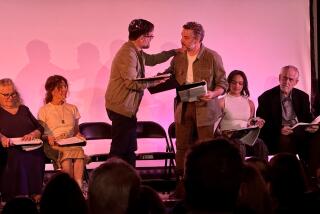Actors Rob Hanley Play of Energy
When a playwright creates a so-called actorâs vehicle, more often than not it means he has written a play that is long on character revelations but short on dramatic significance.
William Hanleyâs âSlow Dance on the Killing Ground,â which opened this weekend at the Alternative Repertory Theatre in Santa Ana, offers a ride in a polished coupe with an engine that purrs like a kitten, yet lacks a tiger in its tank.
As Clive Barnes once put it, this three-character soap opera is the perfect instance of âthe good-bad play.â Backhanded though it sounds, Barnes meant that as praise.
Masterpieces are hard to come by, he noted. Thus, the good-bad play becomes the lifeblood of the theater.
This was true a quarter of a century ago on Broadway, where âSlow Danceâ had its world premiere in 1964, but is no less true today at theater companies across the country. Actors need to work, so second-rate plays are welcomed of necessity by artistic directors with seasons to fill. So much the better if the plays are well crafted.
For ART, which prides itself on being a thinking personâs theater, âSlow Danceâ had still more to recommend it. Hanley took on Big Issues. Within the confines of a Brooklyn candy store, the play dramatizes the Secret Guilt of a Holocaust Survivor, the Grim Despair of a Black Inner-City Youth, the Honesty and Shame of a Woman Seeking an Abortion.
Even if it does boggle the mind like the front page of a supermarket tabloid, you canât get more issue-oriented than that. The prescient intersection of Deeply Disturbing Topics--given their up-to-the-minute currency--is by itself amazing.
âSlow Danceâ also has the advantage of a small cast, which fits the constraints of ARTâs tiny stage better than anything else has all season.
The play unfolds as Glas (John Merina), a stolid German refugee, is taking inventory in his candy store on the night of June 1, 1962, the day the newspapers have announced the execution of Nazi war criminal Adolf Eichmann for his role in the genocide of Europeâs Jews during World War II.
A dandified, jive-talking black youth named Randall (Michael Hamm) bursts in on Glas, in flight from what he describes as âthe killing groundâ of the streets. Soon the two of them are joined by Rosie (Kelli Evans), a homely college girl from the Bronx who has gotten lost looking for an abortionist.
The âslow danceâ of their mutual confrontation is the substance of Hanleyâs melodrama, which teases dark revelations out of each character. However, if the actors in such a vehicle cannot carry the load, difficulties arise. The good-bad play becomes a bad-bad play. Or so it seemed on opening night Friday, when the production was robbed of all forward motion by two of the three figures.
Hamm, whose revved-up menace and sudden shifts of mood are supposed to propel the action, was numbing in his delivery. Uncertain of his lines, he gave the impression that he was reading them back in his mind. His entire performance was leaden and out of sync. You didnât believe him for a minute, whether he was angry, anguished or amused.
Merinaâs Angst- ridden portrayal of Glas didnât help. It was little more than monotonous, dependent on long silences that should have been profound but were merely soporific, an approximation of a foreign accent and a limp. Evans, who at least brought some semblance of real life to the second act, appeared nonetheless to have arrived from some rural backwoods instead of the Bronx.
Sydell Weinerâs direction was serious and straightforward. Though she could not draw acute performances from her actors, she staged the play with considerable ingenuity in a cramped space that has defeated other directors.
The simple lighting by David C. Palmer went a long way toward opening up the space and giving the production some breathing room, as did his spare set. The costumes by Karen J. Weller looked right.
However, the sound design by Gary Christensen fell short of its ambitions. Textual allusions, such as the choral chants, were pretentious. And some cues (the use of a police siren, for instance) were inept.
âSLOW DANCE ON THE KILLING GROUNDâ
A production of the Alternative Repertory Theatre. Written by William Hanley. Directed by Sydell Weiner. Produced by Kathleen A. Bryson. With Michael Hamm, John Merina and Kelli Evans.
The play continues Thursdays to Saturdays at 8 p.m., Sundays at 7 p.m., through June 3. The theater is at 1636 S. Grand Ave. (near Edinger Avenue) in Santa Ana. Tickets are $12 ($10 for students and the elderly). Information: (714) 836-7929.
More to Read
The biggest entertainment stories
Get our big stories about Hollywood, film, television, music, arts, culture and more right in your inbox as soon as they publish.
You may occasionally receive promotional content from the Los Angeles Times.










